NinaPro肌电数据集(52类动作)
目录
1sEMG Data
subjucts : 67 intact subjects & 11 trans-radial amputated subjects
Sensors : 10 Otto Bock (100HZ) & 12 Deslys (2KHZ)
Methods : 5s movement & 3s rest (Repeat 10 times)
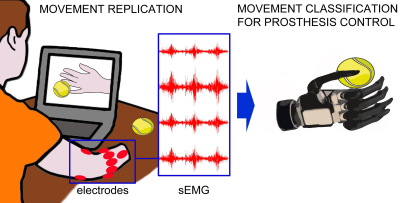
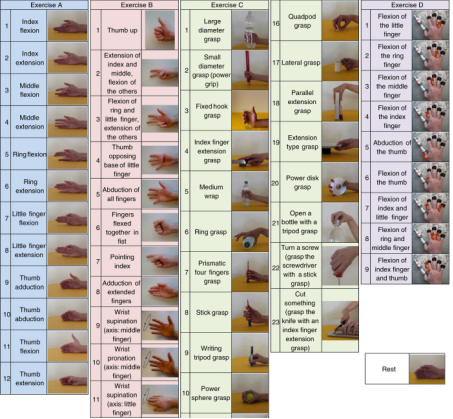
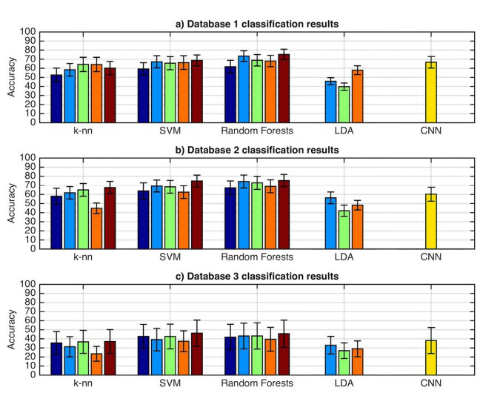
sEMG数据:
(1)使用广义似然比算法 离线重新标记标签
(2)通过RMS校正,使得Delsys信号与Otto Bock信号类似,
之后信号以200HZ下采样,以减少计算时间
(3)都以 1HZ低通滤波
(4)预处理过程中还对几个归一化程序进行了测试
2简单ANN分类
data: 10 channels (Otto bock)
features: 10 time-domain features
movement: 52 (remove rest)
db1: before cutting (9047 samples)
db2: after cutting (4170 samples)(裁剪掉过度状态、防止过拟合)

Neural Networks model
1 layer model: 100-52
3 layers model : 100-200-160-52
3 layers with dropout: keep_prob = 0.5
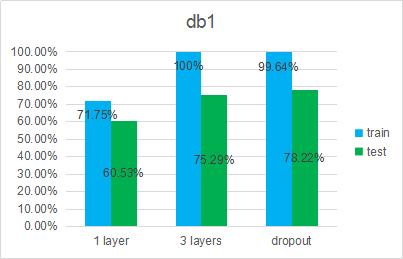
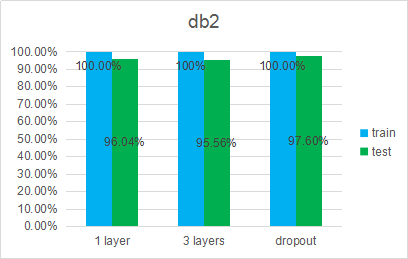
summary
- Before cutting the data, the accuracy is higher than the author’s highest accuracy.
- After cutting the data, the accuracy is greatly improved.
- Dropout has little effect on overfitting.
3层dropout分类
import math
import h5py
import scipy
import random
import scipy.io as scio
from PIL import Image
from scipy import ndimage
from tensorflow.python.framework import ops
import tensorflow as tf
import numpy as np
import matplotlib.pyplot as plt
import pydot
from matplotlib.pyplot import imshow
%matplotlib inline
np.random.seed(1)
def convert_to_one_hot(Y, C):
Y = np.eye(C)[Y.reshape(-1)].T
return Y
def max_min_normalization(data_array):
rows = data_array.shape[0]
cols = data_array.shape[1]
temp_array = np.zeros((rows,cols))
col_min = data_array.min(axis=0)
col_max = data_array.max(axis=0)
for i in range(0,rows,1):
for j in range(0,cols,1):
temp_array[i][j] = (data_array[i][j]-col_min[j])/(col_max[j]-col_min[j])
return temp_array
def random_mini_batches(X, Y, mini_batch_size = 64, seed = 0):
"""
Creates a list of random minibatches from (X, Y)
Arguments:
X -- input data, of shape (input size, number of examples)
Y -- true "label" vector (containing 0 if cat, 1 if non-cat), of shape (1, number of examples)
mini_batch_size - size of the mini-batches, integer
seed -- this is only for the purpose of grading, so that you're "random minibatches are the same as ours.
Returns:
mini_batches -- list of synchronous (mini_batch_X, mini_batch_Y)
"""
m = X.shape[1] # number of training examples
mini_batches = []
np.random.seed(seed)
# Step 1: Shuffle (X, Y)
permutation = list(np.random.permutation(m))
shuffled_X = X[:, permutation]
shuffled_Y = Y[:, permutation].reshape((Y.shape[0],m))
# Step 2: Partition (shuffled_X, shuffled_Y). Minus the end case.
num_complete_minibatches = math.floor(m/mini_batch_size) # number of mini batches of size mini_batch_size in your partitionning
for k in range(0, num_complete_minibatches):
mini_batch_X = shuffled_X[:, k * mini_batch_size : k * mini_batch_size + mini_batch_size]
mini_batch_Y = shuffled_Y[:, k * mini_batch_size : k * mini_batch_size + mini_batch_size]
mini_batch = (mini_batch_X, mini_batch_Y)
mini_batches.append(mini_batch)
# Handling the end case (last mini-batch < mini_batch_size)
if m % mini_batch_size != 0:
mini_batch_X = shuffled_X[:, num_complete_minibatches * mini_batch_size : m]
mini_batch_Y = shuffled_Y[:, num_complete_minibatches * mini_batch_size : m]
mini_batch = (mini_batch_X, mini_batch_Y)
mini_batches.append(mini_batch)
return mini_batches
"下载数据和标签"
f = scio.loadmat('db1.mat')
data = f['features'][:,0:100]
label = f['features'][:,100]
"随机打乱数据和标签"
N = data.shape[0]
index = np.random.permutation(N)
data = data[index,:]
label = label[index]
"对数据特征归一化"
data = max_min_normalization(data)
"将label的数据类型改成int,将label的数字都减1"
label = label.astype(int)
label = label - 1
"转换标签为one-hot"
label = label.reshape((1,label.shape[0]))
label = convert_to_one_hot(label,52)
data = data.T
"生成训练样本及标签、测试样本及标签"
num_train = round(N*0.8)
num_test = N-num_train
train_data = data[:,0:num_train]
test_data = data[:,num_train:N]
train_label = label[:,0:num_train]
test_label = label[:,num_train:N]
print("train data shape:",train_data.shape)
print("train label shape:",train_label.shape)
print("test data shape:",test_data.shape)
print("test label shape:",test_label.shape)
X_train = train_data
Y_train = train_label
X_test = test_data
Y_test = test_labeltrain data shape: (100, 7238)
train label shape: (52, 7238)
test data shape: (100, 1809)
test label shape: (52, 1809)
# 1-1、创建占位符
def create_placeholders(n_x, n_y):
"""
Creates the placeholders for the tensorflow session.
Arguments:
n_x -- scalar, size of an image vector (num_px * num_px = 64 * 64 * 3 = 12288)
n_y -- scalar, number of classes (from 0 to 5, so -> 6)
Returns:
X -- placeholder for the data input, of shape [n_x, None] and dtype "float"
Y -- placeholder for the input labels, of shape [n_y, None] and dtype "float"
Tips:
- You will use None because it let's us be flexible on the number of examples you will for the placeholders.
In fact, the number of examples during test/train is different.
"""
X = tf.placeholder(tf.float32, shape = [n_x, None])
Y = tf.placeholder(tf.float32, shape = [n_y, None])
keep_prob = tf.placeholder("float")
return X, Y, keep_prob
# 1-2、初始化参数
def initialize_parameters():
"""
Initializes parameters to build a neural network with tensorflow. The shapes are:
W1 : [200, 100]
b1 : [200, 1]
W2 : [150, 200]
b2 : [150, 1]
W3 : [52, 150]
b3 : [52, 1]
Returns:
parameters -- a dictionary of tensors containing W1, b1, W2, b2, W3, b3
"""
tf.set_random_seed(1) # so that your "random" numbers match ours
W1 = tf.get_variable("W1", [160,100], initializer = tf.contrib.layers.xavier_initializer(seed = 1))
b1 = tf.get_variable("b1", [160,1], initializer = tf.zeros_initializer())
W2 = tf.get_variable("W2", [120,160], initializer = tf.contrib.layers.xavier_initializer(seed = 1))
b2 = tf.get_variable("b2", [120,1], initializer = tf.zeros_initializer())
W3 = tf.get_variable("W3", [52,120], initializer = tf.contrib.layers.xavier_initializer(seed = 1))
b3 = tf.get_variable("b3", [52,1], initializer = tf.zeros_initializer())
parameters = {"W1": W1,
"b1": b1,
"W2": W2,
"b2": b2,
"W3": W3,
"b3": b3}
return parameters
# 1-3、TensorFlow中的前向传播
# tf中前向传播停止在z3,是因为tf中最后的线性层输出是被作为输入计算loss,不需要a3
def forward_propagation(X, parameters, keep_prob):
"""
Implements the forward propagation for the model: LINEAR -> RELU -> LINEAR -> RELU -> LINEAR -> SOFTMAX
Arguments:
X -- input dataset placeholder, of shape (input size, number of examples)
parameters -- python dictionary containing your parameters "W1", "b1", "W2", "b2", "W3", "b3"
the shapes are given in initialize_parameters
Returns:
Z3 -- the output of the last LINEAR unit
"""
W1 = parameters['W1']
b1 = parameters['b1']
W2 = parameters['W2']
b2 = parameters['b2']
W3 = parameters['W3']
b3 = parameters['b3']
Z1 = tf.add(tf.matmul(W1, X), b1) # Z1 = np.dot(W1, X) + b1
A1 = tf.nn.relu(Z1) # A1 = relu(Z1)
Z2 = tf.add(tf.matmul(W2, A1), b2) # Z2 = np.dot(W2, a1) + b2
A2 = tf.nn.relu(Z2) # A2 = relu(Z2)
A2_drop = tf.nn.dropout(A2, keep_prob)
Z3 = tf.add(tf.matmul(W3,A2_drop),b3)
A3 = Z3
return A3
# 1-4、计算成本函数
def compute_cost(A3, Y):
"""
Computes the cost
Arguments:
Z3 -- output of forward propagation (output of the last LINEAR unit), of shape (6, number of examples)
Y -- "true" labels vector placeholder, same shape as Z3
Returns:
cost - Tensor of the cost function
"""
# to fit the tensorflow requirement for tf.nn.softmax_cross_entropy_with_logits(...,...)
logits = tf.transpose(A3)
labels = tf.transpose(Y)
# 函数输入:shape =(样本数,类数)
# tf.reduce_mean()
cost = tf.reduce_mean(tf.nn.softmax_cross_entropy_with_logits(logits = logits, labels = labels))
return cost
# 1-6、建立模型
def model(X_train, Y_train, X_test, Y_test, learning_rate = 0.0001,
num_epochs = 3001, minibatch_size = 32, print_cost = True):
ops.reset_default_graph() # to be able to rerun the model without overwriting tf variables
tf.set_random_seed(1) # to keep consistent results
seed = 3 # to keep consistent results
(n_x, m) = X_train.shape # (n_x: input size, m : number of examples in the train set)
n_y = Y_train.shape[0] # n_y : output size
costs = [] # To keep track of the cost
X, Y ,keep_prob = create_placeholders(n_x, n_y)
parameters = initialize_parameters()
A3 = forward_propagation(X, parameters, keep_prob)
cost = compute_cost(A3, Y)
optimizer = tf.train.AdamOptimizer(learning_rate = learning_rate).minimize(cost)
init = tf.global_variables_initializer()
# 开始tf会话,计算tf图
with tf.Session() as sess:
sess.run(init)
for epoch in range(num_epochs):
epoch_cost = 0. # Defines a cost related to an epoch
num_minibatches = int(m / minibatch_size) # number of minibatches
seed = seed + 1
minibatches = random_mini_batches(X_train, Y_train, minibatch_size, seed)
for minibatch in minibatches:
(minibatch_X, minibatch_Y) = minibatch
_ , minibatch_cost = sess.run([optimizer, cost], feed_dict = {X: minibatch_X, Y: minibatch_Y, keep_prob:0.5})
epoch_cost += minibatch_cost / num_minibatches
# Print the cost every epoch
if print_cost == True and epoch % 100 == 0:
print ("Cost after epoch %i: %f" % (epoch, epoch_cost))
correct_prediction = tf.equal(tf.argmax(A3), tf.argmax(Y))
accuracy = tf.reduce_mean(tf.cast(correct_prediction, "float"))
print ("Train Accuracy:", accuracy.eval({X: X_train, Y: Y_train, keep_prob: 1}))
print ("Test Accuracy:", accuracy.eval({X: X_test, Y: Y_test, keep_prob: 1}))
if print_cost == True and epoch % 10 == 0:
costs.append(epoch_cost)
# plot the cost
plt.plot(np.squeeze(costs))
plt.ylabel('cost')
plt.xlabel('iterations (per tens)')
plt.title("Learning rate =" + str(learning_rate))
plt.show()
# 将parameters保存在一个变量中
parameters = sess.run(parameters)
print ("Parameters have been trained!")
# Calculate the correct predictions
correct_prediction = tf.equal(tf.argmax(A3), tf.argmax(Y))
# Calculate accuracy on the test set
accuracy = tf.reduce_mean(tf.cast(correct_prediction, "float"))
print ("Train Accuracy:", accuracy.eval({X: X_train, Y: Y_train, keep_prob:1}))
print ("Test Accuracy:", accuracy.eval({X: X_test, Y: Y_test, keep_prob:1}))
return parameters
parameters = model(X_train, Y_train, X_test, Y_test)Parameters have been trained!
Train Accuracy: 0.985908
Test Accuracy: 0.77225
3Deep learning applied to Ninapro

(1)输入数据:对应于150ms的时间窗口,跨越所有的电极
分析时间窗口为了实时控制
(2)Block1: 32个滤波器卷积层 + ReLU
滤波器定义为一行,长度为电极数 (1*10)
(3)Block2: 32个滤波器 3*3 + ReLU + average Pool 3*3
(4)Block3: 64个滤波器 5*5 + ReLU + average Pool 3*3
(5)Block4: (Otto Bock)64个滤波器 5*1 + ReLU
(6)Block5: 滤波器大小 1*1 + softmax loss

训练:
(1)根据数据范围,按照百分比初始化卷积层权重
(2)多次测试,使用随机梯度下降,动量0.9,
学习率固定为0.001,权重衰减0.0005,batch_size=256,epoch=30
(3)使用数据增强:数据加倍,信噪比=25加入新数据
结果:
该表报告每个参数与相应的Top-5错误和时期获得的最小Top-1错误。
测试了两种不同的方法:
时间窗口归一化(即,将每个时间窗口减去平均值并除以标准偏差)
基于训练数据的归一化(即,将所有时间窗口减去训练数据的平均值并将其除以训练数据标准偏差)
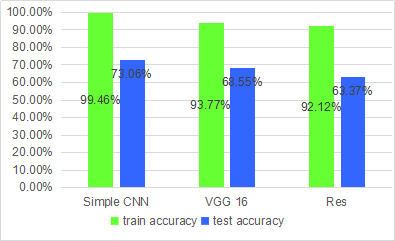
test accuracy 73.06% > 66.59 6.40% (author’s)
sample cnn
import math
import h5py
import scipy
import random
import scipy.io as scio
from PIL import Image
from scipy import ndimage
from tensorflow.python.framework import ops
import time
import tensorflow as tf
import numpy as np
import scipy.misc
import pydot
import matplotlib.pyplot as plt
from matplotlib.pyplot import imshow
from IPython.display import SVG
from keras import layers
from keras.layers import Input, Add, Dense, Activation, ZeroPadding2D, BatchNormalization, Flatten, Conv2D, AveragePooling2D, MaxPooling2D, GlobalMaxPooling2D
from keras.models import Model, load_model
from keras.preprocessing import image
from keras.initializers import glorot_uniform
from keras.applications.imagenet_utils import preprocess_input
from keras.utils import layer_utils
from keras.utils import plot_model
from keras.utils.data_utils import get_file
from keras.utils.vis_utils import model_to_dot
import keras.backend as K
K.set_image_data_format('channels_last')
K.set_learning_phase(1)
%matplotlib inline
np.random.seed(1)
def convert_to_one_hot(Y, C):
Y = np.eye(C)[Y.reshape(-1)].T
return Y
def max_min_normalization(data_array):
rows = data_array.shape[0]
cols = data_array.shape[1]
temp_array = np.zeros((rows,cols))
col_min = data_array.min(axis=0)
col_max = data_array.max(axis=0)
for i in range(0,rows,1):
for j in range(0,cols,1):
temp_array[i][j] = (data_array[i][j]-col_min[j])/(col_max[j]-col_min[j])
return temp_array
def random_mini_batches(X, Y, mini_batch_size = 64, seed = 0):
"""
Creates a list of random minibatches from (X, Y)
Arguments:
X -- input data, of shape (input size, number of examples)
Y -- true "label" vector (containing 0 if cat, 1 if non-cat), of shape (1, number of examples)
mini_batch_size - size of the mini-batches, integer
seed -- this is only for the purpose of grading, so that you're "random minibatches are the same as ours.
Returns:
mini_batches -- list of synchronous (mini_batch_X, mini_batch_Y)
"""
m = X.shape[1] # number of training examples
mini_batches = []
np.random.seed(seed)
# Step 1: Shuffle (X, Y)
permutation = list(np.random.permutation(m))
shuffled_X = X[:, permutation]
shuffled_Y = Y[:, permutation].reshape((Y.shape[0],m))
# Step 2: Partition (shuffled_X, shuffled_Y). Minus the end case.
num_complete_minibatches = math.floor(m/mini_batch_size) # number of mini batches of size mini_batch_size in your partitionning
for k in range(0, num_complete_minibatches):
mini_batch_X = shuffled_X[:, k * mini_batch_size : k * mini_batch_size + mini_batch_size]
mini_batch_Y = shuffled_Y[:, k * mini_batch_size : k * mini_batch_size + mini_batch_size]
mini_batch = (mini_batch_X, mini_batch_Y)
mini_batches.append(mini_batch)
# Handling the end case (last mini-batch < mini_batch_size)
if m % mini_batch_size != 0:
mini_batch_X = shuffled_X[:, num_complete_minibatches * mini_batch_size : m]
mini_batch_Y = shuffled_Y[:, num_complete_minibatches * mini_batch_size : m]
mini_batch = (mini_batch_X, mini_batch_Y)
mini_batches.append(mini_batch)
return mini_batches
"下载数据和标签"
d = scio.loadmat('data1.mat')
data = d['data']
label = d['label']
print('data shape = ',data.shape)
print('label shape = ',label.shape)
"随机打乱数据和标签"
N = data.shape[0]
index = np.random.permutation(N)
data = data[index,:,:]
label = label[index,:]
"对数据data升维度,并且标签 one-hot"
data = np.expand_dims(data, axis=3)
label=label-1
label = convert_to_one_hot(label,52).T
print(data.shape, label.shape)
"选取训练样本、测试样本"
N = data.shape[0]
num_train = round(N*0.9)
num_test = N-num_train
X_train = data[0:num_train,:,:,:]
Y_train = label[0:num_train,:]
X_test = data[num_train:N,:,:,:]
Y_test = label[num_train:N,:]
print(" ")
print ("number of training examples = " + str(X_train.shape[0]))
print ("number of test examples = " + str(X_test.shape[0]))
print ("X_train shape: " + str(X_train.shape))
print ("Y_train shape: " + str(Y_train.shape))
print ("X_test shape: " + str(X_test.shape))
print ("Y_test shape: " + str(Y_test.shape))
data shape = (11322, 16, 10)
label shape = (11322, 1)
(11322, 16, 10, 1) (11322, 52)
number of training examples = 10190
number of test examples = 1132
X_train shape: (10190, 16, 10, 1)
Y_train shape: (10190, 52)
X_test shape: (1132, 16, 10, 1)
Y_test shape: (1132, 52)
def CNN_semg(input_shape=(16,10,1), classes=52):
X_input = Input(input_shape)
"block 1"
"32 filters, a row of the length of number of electrodes, ReLU"
X = Conv2D(filters=32, kernel_size=(1,10), strides=(1,1),padding='same', name='conv1')(X_input)
X = Activation('relu', name='relu1')(X)
"block 2"
"32 filters 3*3, ReLU, average pool 3*3"
X = Conv2D(filters=32, kernel_size=(3,3), strides=(1,1),padding='same', name='conv2')(X)
X = Activation('relu', name='relu2')(X)
X = AveragePooling2D((3,3), strides=(2,2), name='pool1')(X)
"block 3"
"64 filters 5*5, ReLu, average pool 3*3"
X = Conv2D(filters=64, kernel_size=(5,5), strides=(1,1),padding='same', name='conv3')(X)
X = Activation('relu', name='relu3')(X)
X = AveragePooling2D((3,3), strides=(1,1), name='pool2')(X)
"block 4"
"64 filters 5*1, ReLU"
X = Conv2D(filters=64, kernel_size=(5,1), strides=(1,1),padding='same', name='conv4')(X)
X = Activation('relu', name='relu4')(X)
"block 5"
"filters 1*1, softmax loss"
#X = Conv2D(filters=32, kernel_size=(1,1), strides=(1,1),padding='same', name='conv5')(X)
X = Flatten(name='flatten')(X)
#X = Dense(256, activation='relu', name='fc1')(X)
X = Dense(classes, activation='softmax', name='fc2')(X)
model = Model(inputs=X_input, outputs=X, name='CNN_semg')
return model
model = CNN_semg(input_shape = (16, 10, 1), classes = 52)
model.compile(optimizer='adam', loss='categorical_crossentropy', metrics=['accuracy'])
model.fit(X_train, Y_train, epochs=100, batch_size=64)
preds_train = model.evaluate(X_train, Y_train)
print("Train Loss = " + str(preds_train[0]))
print("Train Accuracy = " + str(preds_train[1]))
preds_test = model.evaluate(X_test, Y_test)
print("Test Loss = " + str(preds_test[0]))
print("Test Accuracy = " + str(preds_test[1]))Train Loss = 0.201551189249
Train Accuracy = 0.931207065716
Test Loss = 1.70914583493
Test Accuracy = 0.699646642899
"打印模型图层细节"
model.summary()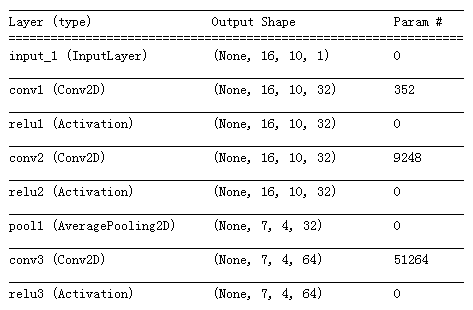
VGG16
def VGG16_semg(input_shape=(16,10,1), classes=52):
X_input = Input(input_shape)
"block 1"
X = Conv2D(filters=4, kernel_size=(3,3), strides=(1,1), activation='relu', padding='same', name='block1_conv1')(X_input)
X = BatchNormalization(axis=3)(X)
X = Conv2D(filters=4, kernel_size=(3,3), strides=(1,1), activation='relu', padding='same', name='block1_conv2')(X)
"block 2"
X = Conv2D(filters=8, kernel_size=(3,3), strides=(1,1), activation='relu', padding='same', name='block2_conv1')(X)
X = BatchNormalization(axis=3)(X)
X = Conv2D(filters=8, kernel_size=(3,3), strides=(1,1), activation='relu', padding='same', name='block2_conv2')(X)
X = BatchNormalization(axis=3)(X)
"block 3"
X = Conv2D(filters=16, kernel_size=(3,3), strides=(1,1), activation='relu', padding='same', name='block3_conv1')(X)
X = BatchNormalization(axis=3)(X)
X = Conv2D(filters=16, kernel_size=(3,3), strides=(1,1), activation='relu', padding='same', name='block3_conv2')(X)
X = BatchNormalization(axis=3)(X)
X = Conv2D(filters=16, kernel_size=(3,3), strides=(1,1), activation='relu', padding='same', name='block3_conv3')(X)
X = BatchNormalization(axis=3)(X)
X = AveragePooling2D((2,2), strides=(2,2), name='block3_pool')(X)
"block 4"
X = Conv2D(filters=32, kernel_size=(3,3), strides=(1,1), activation='relu', padding='same', name='block4_conv1')(X)
X = BatchNormalization(axis=3)(X)
X = Conv2D(filters=32, kernel_size=(3,3), strides=(1,1), activation='relu', padding='same', name='block4_conv2')(X)
X = BatchNormalization(axis=3)(X)
X = Conv2D(filters=32, kernel_size=(3,3), strides=(1,1), activation='relu', padding='same', name='block4_conv3')(X)
X = BatchNormalization(axis=3)(X)
"block 5"
X = Conv2D(filters=32, kernel_size=(3,3), strides=(1,1), activation='relu', padding='same', name='block5_conv1')(X)
X = BatchNormalization(axis=3)(X)
X = Conv2D(filters=32, kernel_size=(3,3), strides=(1,1), activation='relu', padding='same', name='block5_conv2')(X)
X = BatchNormalization(axis=3)(X)
X = Conv2D(filters=32, kernel_size=(3,3), strides=(1,1), activation='relu', padding='same', name='block5_conv3')(X)
X = BatchNormalization(axis=3)(X)
X = Flatten(name='flatten')(X)
X = Dense(256, activation='relu', name='fc1')(X)
X = Dense(classes, activation='softmax', name='fc2')(X)
model = Model(inputs=X_input, outputs=X, name='VGG16_semg')
return model
ResNet50
#残差块:标准块、卷积块
# 1、identity block
def identity_block(X, f, filters, stage, block):
# defining name basis
conv_name_base = 'res' + str(stage) + block + '_branch'
bn_name_base = 'bn' + str(stage) + block + '_branch'
F1, F2, F3 = filters
# save the input value
X_shortcut = X
# first component of main path
X = Conv2D(filters=F1, kernel_size=(1,1), strides=(1,1), padding='valid',
name=conv_name_base+'2a', kernel_initializer=glorot_uniform(seed=0))(X)
X = BatchNormalization(axis=3, name=bn_name_base+'2a')(X)
X = Activation('relu')(X)
# second component of main path
X = Conv2D(filters=F2, kernel_size=(f,f), strides=(1,1), padding='same',
name=conv_name_base+'2b', kernel_initializer=glorot_uniform(seed=0))(X)
X = BatchNormalization(axis=3, name=bn_name_base+'2b')(X)
X = Activation('relu')(X)
# Third component of main path
X = Conv2D(filters=F3, kernel_size=(1,1), strides=(1,1), padding='valid',
name=conv_name_base+'2c', kernel_initializer=glorot_uniform(seed=0))(X)
X = BatchNormalization(axis=3, name=bn_name_base+'2c')(X)
# Final step
# Add shortcut value to main path, and pass it through a ReLU activation
X = Add()([X, X_shortcut])
X = Activation('relu')(X)
return X
# 2、convolutional block
def convolutional_block(X, f, filters, stage, block, s=2):
"""
Implementation of the identity block
Arguments:
X -- input tensor of shape (m, n_H_prev, n_W_prev, n_C_prev)
f -- integer, 主路径中间的那个CONV的窗口形状
filters -- python整数列表, 定义主路径每个CONV层中的滤波器的数量
stage --整数,用于命名层,取决于他们在网络中的位置 阶段
block --字符串/字符,用于命名层,取决于他们在网络中的位置 块
s -- 整数,指定滑动的大小
Returns:
X -- output of the identity block, tensor of shape (n_H, n_W, n_C)
"""
# defining name basis
conv_name_base = 'res' + str(stage) + block + '_branch'
bn_name_base = 'bn' + str(stage) + block + '_branch'
F1, F2, F3 = filters
# save the input value
X_shortcut = X
# first component of main path
X = Conv2D(filters=F1, kernel_size=(1,1), strides=(s,s), padding='valid',
name=conv_name_base+'2a', kernel_initializer=glorot_uniform(seed=0))(X)
X = BatchNormalization(axis=3, name=bn_name_base+'2a')(X)
X = Activation('relu')(X)
# second component of main path
X = Conv2D(filters=F2, kernel_size=(f,f), strides=(1,1), padding='same',
name=conv_name_base+'2b', kernel_initializer=glorot_uniform(seed=0))(X)
X = BatchNormalization(axis=3, name=bn_name_base+'2b')(X)
X = Activation('relu')(X)
# Third component of main path
X = Conv2D(filters=F3, kernel_size=(1,1), strides=(1,1), padding='valid',
name=conv_name_base+'2c', kernel_initializer=glorot_uniform(seed=0))(X)
X = BatchNormalization(axis=3, name=bn_name_base+'2c')(X)
# shortcut path
X_shortcut = Conv2D(filters=F3, kernel_size=(1,1), strides=(s,s), padding='valid',
name=conv_name_base+'1', kernel_initializer=glorot_uniform(seed=0))(X_shortcut)
X_shortcut = BatchNormalization(axis=3, name=bn_name_base+'1')(X_shortcut)
# Final step
# Add shortcut value to main path, and pass it through a ReLU activation
X = Add()([X, X_shortcut])
X = Activation('relu')(X)
return X
def ResNet50_semg(input_shape=(16,10,1), classes=52):
X_input = Input(input_shape)
# stage 1
X = Conv2D(filters=4, kernel_size=(3,3), strides=(1,1), padding='valid',
name='conv1', kernel_initializer=glorot_uniform(seed=0))(X_input)
X = BatchNormalization(axis=3, name='bn_conv1')(X)
X = Activation('relu')(X)
X = MaxPooling2D((2,2), strides=(2,2))(X)
# stage 2
X = convolutional_block(X, f=3, filters=[4,4,16], stage=2, block='a', s=1)
X = identity_block(X, f=3, filters=[4,4,16], stage=2, block='b')
X = identity_block(X, f=3, filters=[4,4,16], stage=2, block='c')
# stage 3
X = convolutional_block(X, f=3, filters=[8,8,32], stage=3, block='a', s=1)
X = identity_block(X, f=3, filters=[8,8,32], stage=3, block='b')
X = identity_block(X, f=3, filters=[8,8,32], stage=3, block='c')
X = identity_block(X, f=3, filters=[8,8,32], stage=3, block='d')
# stage 4
X = convolutional_block(X, f=3, filters=[16,16,64], stage=4, block='a', s=1)
X = identity_block(X, f=3, filters=[16,16,64], stage=4, block='b')
X = identity_block(X, f=3, filters=[16,16,64], stage=4, block='c')
X = identity_block(X, f=3, filters=[16,16,64], stage=4, block='d')
X = identity_block(X, f=3, filters=[16,16,64], stage=4, block='e')
X = identity_block(X, f=3, filters=[16,16,64], stage=4, block='f')
# stage 5
X = convolutional_block(X, f=3, filters=[16,16,64], stage=5, block='a', s=1)
X = identity_block(X, f=3, filters=[16,16,64], stage=5, block='b')
X = identity_block(X, f=3, filters=[16,16,64], stage=5, block='c')
# fully connected output layer
X = Flatten(name='flatten')(X)
X = Dense(256, activation='relu', name='fc1')(X)
X = Dense(classes, activation='softmax', name='fc2')(X)
model = Model(inputs=X_input, outputs=X, name='ResNet50_semg')
return model










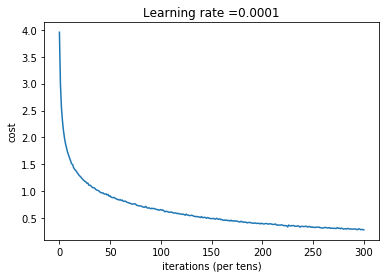
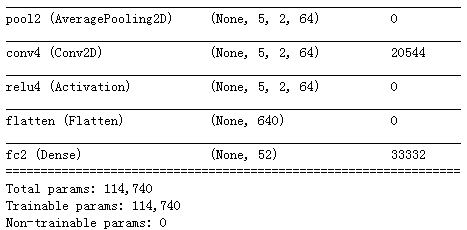














 4003
4003

 被折叠的 条评论
为什么被折叠?
被折叠的 条评论
为什么被折叠?








